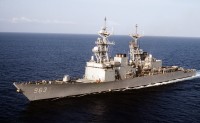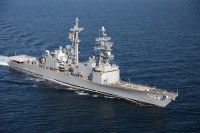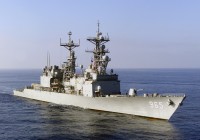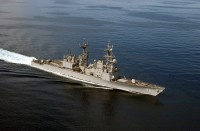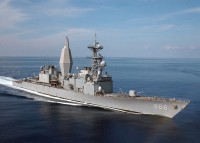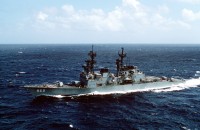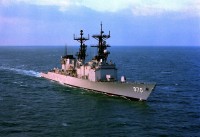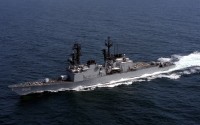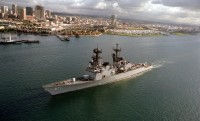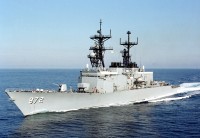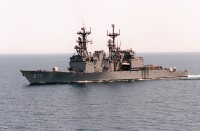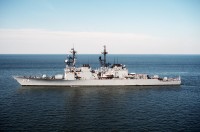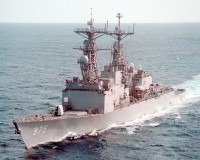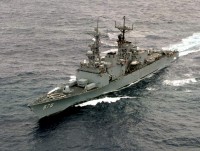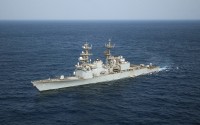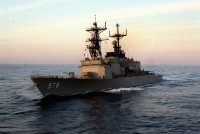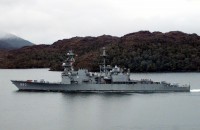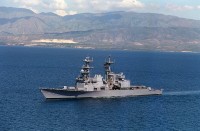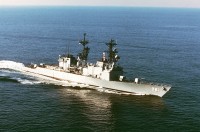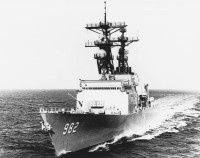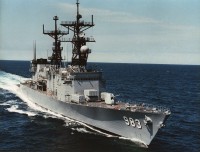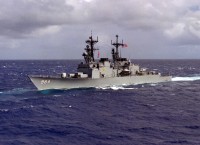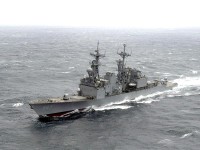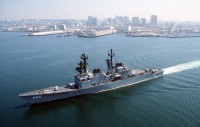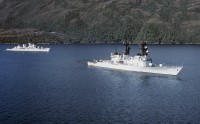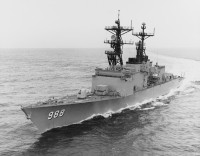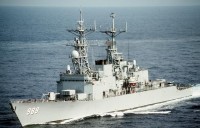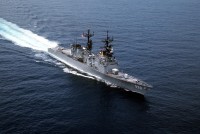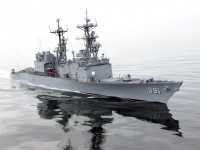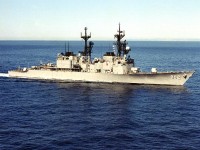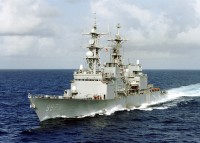Есмінці класу «Спрюенс»
Основна інформація
Головні розміри
Машина
- 4 * General Electric LM2500 gas turbines, 2 shafts, 80,000 shp (60 MW)
Персонал
Бойові сили та засоби
- AN/SPS-40 air search radar
- AN/SPG-60 fire control radar
- AN/SPS-55 surface search radar
- AN/SPQ-9 gun fire control radar
- Mark 23 TAS automatic detection and tracking radar
- AN/SPS-65 Missile fire control radar
- AN/SQS-53 bow mounted Active sonar
- AN/SQR-19 TACTAS towed array Passive sonar
- Naval Tactical Data System
- AN/SLQ-32 Electronic Warfare System
- AN/SLQ-25 Nixie Torpedo Countermeasures
- Mark 36 SRBOC Decoy Launching System
- AN/SLQ-49 Inflatable Decoys
- AN/WLR 1 in DD-971 & DD-975
As built
- 2 * 5-inch (127mm) 54 calibre Mark 45 dual purpose guns
- 1 * 8-cell ASROC launcher
- 1 * 8-cell NATO Sea Sparrow Mark 29 missile launcher
- 2 * Mark 32 triple 12.75 in (324 mm) torpedo tubes (Mk 46 torpedoes) (14 torpedoes)
Later fitted
- 2 * Quadruple Harpoon missile canisters
- 2 * 20 mm Phalanx CIWS Mark 15 guns
- 2 * Quadruple ABL Mark 143 Tomahawk missile launchers (7 ships)
- 1 * 61-cell Mark 41 VLS launcher for Tomahawk/ASROC missiles in place of the 8-cell ASROC launcher (24 ships)
- 1 * 21-cell Rolling Airframe Missile launcher on some ships
- 2 * Sikorsky SH-60 Seahawk LAMPS III helicopters
Spruance-class destroyer emerged from the United States as a replacement for the numerous Allen M. Sumner- and Gearing-class destroyers from World War II. This class took center stage as the primary destroyer crafted for the United States Navy throughout the 1970s and 1980s. It was named to honor U.S. Navy Admiral Raymond A. Spruance, celebrated for commanding key naval battles in the Asiatic-Pacific Theater during World War II, including the Battle of Midway and the Battle of the Philippine Sea.
Introduced in 1975, this class was designed with gas-turbine propulsion, featuring a flight deck and hangar capable of hosting up to two medium-lift helicopters. Equipped with all-digital weapons and automated 127 mm (5-inch) guns, the Spruance class initially served as an escort for carrier groups, specializing in anti-submarine warfare (ASW). It was equipped with point-defense anti-aircraft warfare (AAW) missiles and limited anti-ship capabilities. Two dozen ships of this class received upgrades with Tomahawk cruise missiles for land attack. The Navy retired this class earlier than planned, decommissioning the last ship in 2005. Most Spruances were dismantled or used as targets. The hull structure and propulsion system became the basis for the Ticonderoga-class cruisers built in the 1980s. The Arleigh Burke-class destroyer succeeded the Spruance class as the main U.S. destroyer.
Considerably larger than other destroyers of that period, the Spruances were comparable in size to contemporary guided-missile cruisers (CG and CGN) and U.S. Navy light cruisers (CL) from World War II. This allowed them to house a helicopter flight deck, a first for a U.S. Navy destroyer, along with an enclosed hangar capable of accommodating up to two medium-lift helicopters, a feature previously unseen in a U.S. Navy destroyer or cruiser. The «Spru-cans» were the first large U.S. Navy vessels to employ gas turbine propulsion, utilizing four General Electric LM2500 gas turbines generating approximately 80,000 horsepower (60 MW). This configuration, developed in the 1960s by the Royal Canadian Navy for the Iroquois-class destroyers and known as Combined Gas And Gas (COGAG), saw widespread success and adoption in subsequent U.S. warships. By 2010, nearly all U.S. Navy surface combatants (excluding nuclear-powered aircraft carriers and the LCS-1) utilized the LM2500 COGAG arrangement, typically featuring two turbines per shaft.
Initially, these ships faced controversy, especially among members of the United States Congress who perceived their unassuming appearance and original armament of two guns, an ASROC, and Sea Sparrow missile launchers as signs of vulnerability compared to Soviet designs armed with numerous anti-ship missiles. They were also unfavorably compared to earlier U.S. designs that boasted more visible guns or launchers for Standard medium-range missiles. However, proponents highlighted their success in their intended ASW role, attributing it to their seaworthiness, silent operation, and capacity to operate two helicopters.
The Spruance class received the «DD» designation in the hull classification symbol system, even though their primary armament consisted of missiles. However, their initial set of 8 Sea Sparrow anti-aircraft missiles only sufficed for point defense, differing from other American destroyers designated as DDG, designed to provide fleet anti-aircraft warfare screening. In the early 1980s, the class received quadruple Harpoon missile launchers installed amidships. Six members received Armored Box Launchers Tomahawk surface-to-surface missiles, while an extensive upgrade from the mid-1980s for 24 members added a 61-cell Vertical Launch Missile System (VLS) for the Tomahawk. Despite these enhancements, the class retained its DD classification due to the absence of area anti-aircraft capabilities compared to guided-missile cruisers (CG and CGN) and destroyers (DDG).
Up until the class was named after Admiral Spruance, the acquisition effort was known as the DX program. It aimed to grant the production contract for the entire class of 30 ships to a single shipyard under the Total Package Procurement concept, originating from Robert McNamara's Pentagon's «Whiz Kids.» The idea was to benefit from mass construction. Following a selection process marked by political influence and shifting rules, the entire contract was awarded on 23 June 1970 to the Litton-Ingalls shipyard in Pascagoula, Mississippi. Labor and technical issues led to cost overruns and construction delays.
One additional ship, USS Hayler, was ordered on 29 September 1979. Initially intended as a DDH (Destroyer, Helicopter) variant carrying more anti-submarine helicopters than the standard Spruance class, this plan was eventually discarded, and a slightly modified DD-963 class hull was commissioned.
Four extra ships, initially crafted for the Iranian Navy with the Mark 26/Standard AAW missile system, were commissioned as the Kidds for the U.S. Navy. These Kidd-class destroyers shared the same hull as the Spruances but featured more advanced general-purpose capabilities with area anti-air warfare capacities absent in the Spruance class. There were plans to elevate the entire Spruance class to this standard, but the cost was deemed prohibitive. A slightly elongated hull version was also used for the Ticonderoga-class cruisers, initially planned as DDG-47-class destroyers but later redesignated as cruisers in 1980, emphasizing the additional capability provided by the ships' Aegis combat systems and their facilities suitable for an admiral and staff.
An air-capable mini V/STOL aircraft carrier with fighters and ASW helicopters based on the Spruance hull was seriously considered but was not brought to fruition.
The Spruance design was modular, allowing for the easy installation of complete subsystems within the ship. Although primarily designed for anti-submarine warfare, seven vessels—Comte de Grasse, Merrill, Conolly, John Rodgers, Leftwich, Deyo, and Ingersoll—initially underwent upgrades by incorporating two four-round Armored Box Launchers (ABL) for the Tomahawk cruise missile, positioned on each side of the ASROC launcher, providing them with land attack capability. Subsequently, 23 remaining vessels received a more comprehensive upgrade by integrating a 61-cell Mark 41 Vertical Launch Missile System (VLS) forward, replacing the ASROC launcher and allowing for a greater arsenal. One of the ABL ships, Deyo, also underwent the VLS upgrade, while Harry W. Hill was the only Spruance that did not receive the Tomahawk as its VLS upgrade was canceled. Hill and the remaining six ABL-equipped ships were the first of the class to be withdrawn from service.
Merrill served as the Navy's test platform for the Tomahawk Cruise Missile Program, receiving armored box launchers and successfully test-launching a Tomahawk on 19 March 1980. Merrill maintained two ABLs and an ASROC launcher until the 1990s when the ASROC launcher was removed.
Кораблі31
- Коментарі
 uk
uk en
en ru
ru
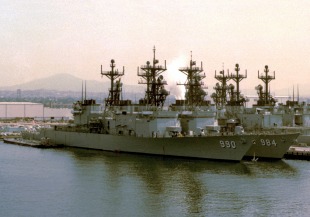





 Військово-Морські Сили США
Військово-Морські Сили США Ingalls Shipbuilding
Ingalls Shipbuilding